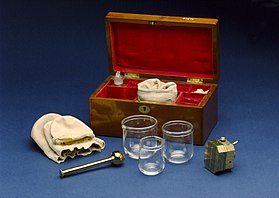Fire cupping
| Cupping therapy | |
|---|---|

Cupping set, from London, England, dating from 1860–1875
|
|
| Alternative therapy | |
| Benefits | Placebo |
Cupping therapy is a form of alternative medicine in which a local suction is created on the skin. Cupping has been characterized as pseudoscience. There is no good evidence it has any benefit on health and there are some concerns it may be harmful.
Through suction, the skin is drawn into the cup by creating a vacuum in the cup placed on the skin over the targeted area. The vacuum can be created either by the heating and subsequent cooling of the air in the cup, or via a mechanical pump. The cup is usually left in place for somewhere between five and fifteen minutes. It is believed by some to help treat pain, deep scar tissues in the muscles and connective tissue, muscle knots, and swelling; however, the efficacy of this is unproven.
Cupping is poorly supported by scientific evidence. In their 2008 book Trick or Treatment, Simon Singh and Edzard Ernst write that no evidence exists of any beneficial effects of cupping for any medical condition. A 2011 review found tentative evidence for pain but nothing else.
The way it works is unclear but might involve the placebo effect.
Advocates claim that cupping is an alternative treatment for cancer. However, the American Cancer Society notes that "available scientific evidence does not support claims that cupping has any health benefits" and also that the treatment carries a small risk of burns.
Cupping is generally safe when applied by trained professionals on people who are otherwise healthy. It is not recommended for people with health problems due to side effects. Cupping is not recommended as a replacement for typical treatment. Cupping may result in bruising, burns, pain, and/or skin infection.
Cupping therapy adverse events can be divided into local and systemic adverse events. The local adverse events were scar information, burn, skin infection, panniculitis, abscess formation, pain at cupping site, and systemic adverse events include: anemia, dizziness, vasovagal attack insomnia, headaches and nausea.
Research suggests that cupping is harmful, especially in people who are thin or obese: According to Jack Raso (1997), cupping results in capillary expansion, excessive fluid accumulation in tissues, and the rupture of blood vessels.
...
Wikipedia
